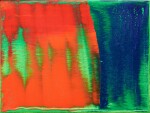The Swiss Fine Art Sale
The Swiss Fine Art Sale

Gerhard Richter
Grün-Blau-Rot, 1993
Lot Closed
June 15, 01:05 PM GMT
Estimate
260,000 - 350,000 CHF
Lot Details
Description
Gerhard Richter
b. 1932
Grün-Blau-Rot, 1993
Oil on canvas
Signed, dated and numbered 789-66 on the reverse
30 x 40 cm (unframed); 39.5 x 49.5 cm (framed)
This work is from an edition of 115 unique variants.
Acquired from the above by the present owner in 1993
Barbara Bloom, Gerhard Richter, in Parkett, Zurich, no. 35, 1993, p. 99, ill.
Hubertus Butin, Gerhard Richter. Editionen 1965-1993, Bremen, 1993, pp. 166-167, no. 69, ill.
Exh. Cat., Bonn, Kunst- und Ausstellungshalle der Bundesrepublik Deutschland, Gerhard Richter: 1962-1993, 1993-1994, no. 789-66, ill.
Hubertus Butin and Stefan Gronert (eds.), Gerhard Richter. Editionen 1965-2004, Ostfildern, 2004, p. 229, no. 81, another example illustrated
Hubertus Butin, Stefan Gronert and Thomas Olbricht (eds.), Gerhard Richter. Editionen 1965-2013 (catalogue raisonné), Ostfildern, 2014, p. 252, no. 81, another example illustrated
Dietmar Elger, Gerhard Richter, Catalogue Raisonné, Nos. 652-1-805-6, Vol. 4, 1988-1994, Ostfildern, 2015, pp. 524-525, no. 789-66, ill.
Hubertus Butin, Gerhard Richter. Unikate in Serie, Cologne, 2017, pp. 132-133, another example illustrated
Displaying a vibrant amalgamation of richly textured primary colours, Grün-Blau-Rot stands as an exceptional example of Richter’s exploration of abstract painting. As part of a series of 115 paintings, of which each is unique, the present work is testament to Richter’s rigorously conceptual approach towards painting. The inherent seriality of the Grün-Blau-Rot paintings emphasizes Richter's interest in the photographic medium and establishes a conceptual and historic dialogue with his very first photo-realistic paintings from the 1960s.
The mechanical, arbitrary mode of execution in Grün-Blau-Rot epitomizes Richter's bridging of the two apparently dichotomous realms that are abstraction and figuration. Indeed, the present work’s title and its colour palette, immediately recalls the ‘RGB’ (red, green and blue) colour model – through which the three main light wavelengths merge to create images in analogue photography. In doing so Grün-Blau-Rot perfectly embodies Richter’s declaration: “I’m not trying to imitate a photograph, I’m trying to make one. And if I disregard the assumption that a photograph is a piece of paper exposed to light, then I am practicing photography by other means. Those of my paintings that have no photographic source (e.g. the abstracts) are also photographs.” (Gerhard Richter cited in: Katja Silverman, Flesh of my Flesh, California 2009, p. 173).
Reminiscing about his abstract paintings, Richter observed that his approach has enabled him to produce “photography by other means” (Gerhard Richter in conversation with Rolf Schön (1972) in: Dietmar Elger and Hans Ulrich Obrist, Eds., Gerhard Richter, TEXT: Writings, Interviews and Letters: 1961-2007, London 2009, p. 73). After decades of conceptual enquiry into the very nature of perception and cognition, experimenting with modes of mechanical reproduction and their representation, Grün-Blau-Rot is part of a series of which all have the same format and choice of oil-based pigments, but differ in the chance accretions created by the squeegee technique the artist introduced into his abstract practice in the mid-1980s. With its paint consistency flitting between rich impasto and blurring transparency in the fluent transition of chromatic hues, the present work is a superlative example of this almost obsessive experiment.
